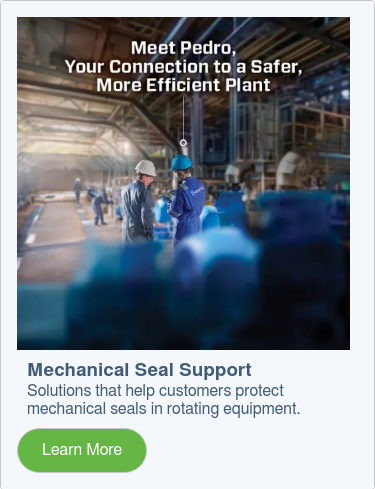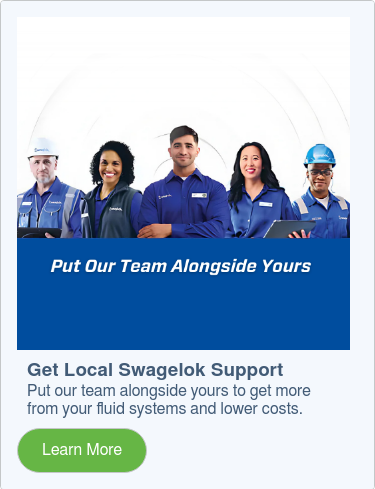Share this
Why Seal Flushing Is Required and How To Minimize Its Frequency
by Malik Durojaiye on 3/9/21 8:45 AM
Selecting the correct mechanical seal for a pump requires a thorough understanding of the pumping process—the fluid, temperature, pressure, and expected operating cycles.
The reliability and performance of centrifugal pumps that process fluids such as irrigation water and high-pressure, high-temperature toxic hydrocarbons depend on the proper functioning of mechanical seals. These carefully engineered components with tight tolerances are designed to prevent leakage.
Equally important in preventing centrifugal pump leakage is the selection of a mechanical seal support system, which is designed to maintain the proper environment for the mechanical seal chamber. When matched with a mechanical seal and pumping conditions, the mechanical seal support system provides lubrication and maintains the proper environment to prevent seal failure and pump leakage.Why seal flushing is required during maintenance
There’s one more critical task in keeping pumps operational—scheduled maintenance procedures for pumps and their seal support systems. Throughout the life of a pump, you can expect to conduct maintenance flushes to prevent or remedy problems with mechanical seal performance. The purpose of the maintenance procedure is to flush any debris from between the seal faces. That debris may have come from particulates in the process fluid, corrosion from aging piping, or metal from an abraded pump volute or impeller.
Requirements and tips for a seal flushing procedure
The fluid used for the seal flush must be compatible with the process fluid. Plant water, a water/glycol mix, or steam delivered at a pressure higher than the process fluid pressure works for process fluids that tolerate water. The alternative is flushing oil, natural or synthetic, pumped at pressure and compatible with the process fluid. In most cases, there’s no need to stop the pumping process. The maintenance flush is delivered via a dedicated flush port in the mechanical seal body and runs long enough to flush any debris that may have accumulated between the seal faces.
Seal flushing frequency
The frequency of mechanical seal flushing depends on process conditions. For properly-maintained centrifugal pumps, the schedule for maintenance flushes should be based on performance data obtained from your EAM system. Considering that some plants have hundreds to thousands of pumps, the time and cost allotted for maintenance flushes could be considerable. Overall, you want to find the right balance between a proactive and reactive seal flushing maintenance schedule.
When is seal flushing required too often?
If you’re conducting seal flush maintenance with increasing frequency to prolong the life of the mechanical seal, it may be time to check for causes of seal degradation. Factors that contribute to seal degradation are usually tied to the inability of the seal support system to maintain the proper seal chamber environment. Let’s consider the most likely reasons, and discuss methods to reduce the frequency of these flushes:
1. Problems cause by particulate and slurries
Process fluids with high particulate concentrations or slurries can impact centrifugal pump and mechanical seal integrity. You’d expect these pumps to require seal flushing more frequently to clear particulates from the seal chamber, mechanical seal components, and seal faces.
Nonetheless, if your EAM system shows that the MTBF for a particular pump is lower than the average for pumps of that class and process conditions, look into these factors that can be affecting pump performance:
- Consider replacing the filter/strainer on the seal support system (API Plans 12 and 22) with a cyclone separator (API Plan 31 or 41) to more effectively remove particulates from the process fluid delivered to the seal chamber. Building in a bypass makes filter swaps simple and environmentally safe.
- Upgrade a single, process-side mechanical seal and seal support system to a dual-seal with a barrier fluid seal support system (API Plans 52, 53A/B/C, 54, or 74) delivered to more effectively prevent particulates from infiltrating seal faces.
2. Inadequate pressure = poor lubrication
If clean, filtered process fluid from the discharge side of the pump is not delivered at the correct pressure (higher than pump chamber), process fluid won’t adequately lubricate the seal faces and prevent particulates from degrading the seal faces—leading to eventual seal failure.
Blockage in a clogged orifice (pump discharge), clogged filter, or accidentally crimped tubing leading from discharge to seal chamber are the likely causes of inadequate pressure. The addition of a pressure gauge and pressure transmitter can alert to pressure drops that need to be addressed immediately.

API Plan 21 - Cooled Flush with gauges to monitor process fluid pressure and alert to problems.
Tips to minimize seal flushing frequency
Seal flushing maintenance procedures should be part of your planned maintenance program, with seal flushing frequency based on maintenance records for that class of pumps with similar pumping conditions. By proactively flushing debris that can damage seal faces, you extend the life of the seal and boost pump reliability. However, if you’re doing more seal flushing than indicated on your scheduled maintenance plan, it’s likely that the problem is an underperforming seal support system.
Getting help with seal flushing
Some of the recommendations mentioned above to reduce the requirement for seal flushing could easily be handled by your maintenance team, but I’ve found that some solutions benefit from the guidance of an experienced fluid system engineer. An experienced Swagelok Field Engineer will be able to do a thorough assessment of issues causing frequent seal failures and recommend changes. These recommendations may involve a simple redesign of the discharge to seal chamber tubing run to improve flow and pressure. It could also identify the need to upgrade to a seal support system that more reliably maintains the required seal chamber environment.How we can help
Swagelok has assisted process engineers and maintenance personnel in the chemical, petroleum, energy, utility, and semiconductor industries in Northern California by designing and assembling seal support systems tailored to the specific needs of each pumping process. With access to a worldwide team of fluid engineering specialists, our experience is unparalleled in helping industries reduce maintenance costs by enhancing pump reliability.
-1.jpg?width=192&name=image8%20(1)-1.jpg) About Malik Durojaiye | Field Engineer, Assembly Services
About Malik Durojaiye | Field Engineer, Assembly Services
Malik Durojaiye began his Swagelok career in 2019 as a Custom Solutions Engineer in our Assembly Services group. Prior to Swagelok, Malik developed as a design engineer as well as a manufacturing engineer for 6 years serving Kentucky and California with Altec Industries; a leading provider of products and services to the electric utility, telecommunications, tree care, lights and signs, and contractor markets.
Share this
- Archive (465)
- Assembly Services (207)
- About (100)
- Seal Support Systems (96)
- Best Practices (88)
- Training Services (74)
- Fittings (51)
- Semiconductor Applications (49)
- Hoses and Flexible Tubing (47)
- Regulators (44)
- Tubing (42)
- Grab Sampling Systems (32)
- Sampling Systems (32)
- Gas Systems (30)
- Services (30)
- Downloads (29)
- Valves (24)
- Application Support (18)
- Orbital Welding (17)
- Case Studies (13)
- Steam Systems (13)
- Frequently Asked Questions (12)
- Tools (12)
- Measurement Devices (7)
- Subsystems (6)
- Thermal Management (6)
- September 2023 (1)
- August 2023 (2)
- June 2023 (1)
- March 2023 (3)
- February 2023 (3)
- January 2023 (4)
- December 2022 (4)
- November 2022 (4)
- October 2022 (4)
- September 2022 (1)
- August 2022 (3)
- July 2022 (2)
- June 2022 (4)
- May 2022 (1)
- April 2022 (2)
- March 2022 (1)
- February 2022 (2)
- January 2022 (3)
- December 2021 (1)
- November 2021 (6)
- October 2021 (6)
- September 2021 (8)
- August 2021 (4)
- July 2021 (3)
- June 2021 (6)
- May 2021 (6)
- April 2021 (7)
- March 2021 (5)
- February 2021 (4)
- January 2021 (6)
- December 2020 (5)
- November 2020 (6)
- October 2020 (6)
- September 2020 (8)
- August 2020 (7)
- July 2020 (8)
- June 2020 (8)
- May 2020 (6)
- April 2020 (9)
- March 2020 (7)
- February 2020 (10)
- January 2020 (21)
- December 2019 (23)
- November 2019 (21)
- October 2019 (22)
- September 2019 (21)
- August 2019 (22)
- July 2019 (23)
- June 2019 (20)
- May 2019 (23)
- April 2019 (22)
- March 2019 (21)
- February 2019 (20)
- January 2019 (21)
- December 2018 (14)
- November 2018 (19)
- October 2018 (23)
- September 2018 (17)
- August 2018 (29)
- July 2018 (11)
- June 2018 (6)
- May 2018 (5)
- April 2018 (4)
- March 2018 (5)
- February 2018 (3)
- January 2018 (3)
- December 2017 (2)
- November 2017 (4)
- October 2017 (3)
- September 2017 (2)
- August 2017 (6)
- July 2017 (4)
- June 2017 (4)
- May 2017 (4)
- April 2017 (3)
- March 2017 (4)
- February 2017 (3)
- January 2017 (3)
- December 2016 (3)
- November 2016 (3)
- October 2016 (3)
- September 2016 (5)
- August 2016 (5)
- July 2016 (4)
- June 2016 (5)
- May 2016 (3)
- April 2016 (4)
- March 2016 (5)
- February 2016 (11)
- January 2016 (1)
- December 2015 (3)
- November 2015 (4)
- October 2015 (3)
- September 2015 (4)
- August 2015 (4)
- July 2015 (8)
- June 2015 (5)
- May 2015 (3)
- April 2015 (4)
- March 2015 (4)
- February 2015 (3)
- January 2015 (4)
- December 2014 (2)
- November 2014 (3)
- October 2014 (4)
- September 2014 (4)
- August 2014 (4)
- July 2014 (5)
- June 2014 (4)
- May 2014 (4)
- April 2014 (5)
- March 2014 (4)
- February 2014 (3)
- January 2014 (4)
- December 2013 (5)
- November 2013 (3)
- October 2013 (4)
- September 2013 (3)
- August 2013 (5)
- July 2013 (5)
- June 2013 (5)
- May 2013 (3)
- April 2013 (6)
- March 2013 (4)
- February 2013 (4)
- January 2013 (8)
- December 2012 (4)
- November 2012 (6)
- October 2012 (6)
- September 2012 (4)
- August 2012 (4)
- July 2012 (4)
- June 2012 (4)

.webp?width=210&height=70&name=StickyLogo%20(5).webp)

